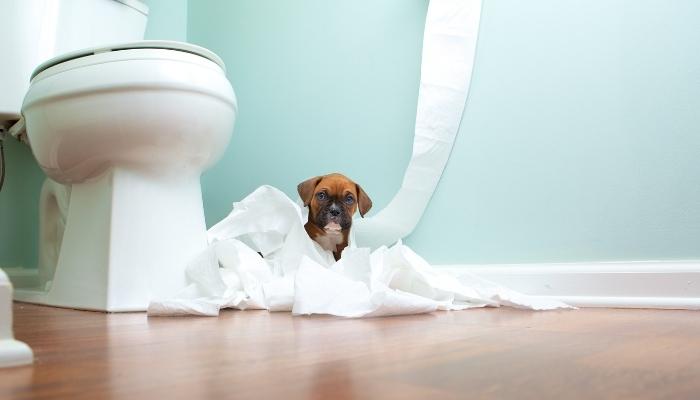
A new pet is a great adventure and one that is going to be filled with excitement and memories that will last a lifetime. From the first day you bring them home, they will instantly make your world a happier place. However, those furry bundles of joy also can wreak havoc – especially to your living space.
While pets are (for the most part) loving creatures, they can be very mischievous and will see everything you own as their potential new toy. To make sure your new, adorable addition brings you nothing but bliss, it would be wise to pet-proof your living space for any potential mishap. Pet-proofing will of course keep your little one safe and secure, but it will also protect your valuables and keep your home more organized.
Here are our best tips to guide you through pet-proofing your living space.
Pet-Proof the Kitchen Space
When starting the pet-proofing process, it’s fair to assume that literally nothing is safe when it comes to what your pet can get into. To ensure your pet’s safety, the first step should be to identify any areas that will definitely need proofing; and the best place to start is the kitchen. The kitchen is where we prepare our meals on top of many other daily necessities and our pets will (most likely), be there begging for food or investigating those mouthwatering smells.

While the kitchen may seem like an inviting place to our four-legged friends, it is potentially the most hazardous area in our homes for them. If you don’t want to give your pets easy access to your kitchen table, for example, make a house rule to always push in the chairs or benches. This way, you can avoid creating a pet-friendly staircase leading directly to your eating surface.
Pet-Proof the Living Room
Once you’ve wrapped up securing the kitchen of any potential harm, it’s time to move onto the most frequented place in your home: the living room. The living room is where you come to relax and put your feet up at the end of a long day, and where your new companion will want to climb on furniture (even if they’re not allowed.) Sometimes it’s tough to think of safety concerns in our cozy sanctuaries, but there are actually several potential hazards that do require pet-proofing.
It is very important to keep all electric cords and chargers tucked away and out of reach; the last thing you want is for your pet to chew through an important energy source and even worse, possibly get electrocuted. Along with electronics, another hazard that might not be on everyone’s mind are those lovely plants around your home. If you decorate your living room with an assortment of plants, you’ll need to keep in mind that several common household plants can be poisonous to our little pals and will need to be kept at a safe distance.
Another solid strategy for pet-proofing the living room would be to select a new sofa with performance fabric that can resist tears and stains, and which can be cleaned or vacuumed without easy damage. Perhaps even adding an ottoman with hidden storage so you can tuck away those throw pillows you think are so cute, but that your dog loves to chew on.
Pet-Proof the Bathroom
After the living room is secured, it’s time to make your way down to another one of our pet’s favorite destinations: the bathroom. Chances are, if your four-legged family member is in the bathroom, they’re probably up to no good. Gulping down toilet water and shredding a roll of toilet paper are just a few of the potential offenses your pet may commit, so you’re going to want to be on top of any other potential accident waiting to happen.

While most of the damage a pet can do in the bathroom is minor, they can find themselves in serious trouble if they get into several wrong things, including medicines, household cleaners, and other common bathroom products like drain cleaner and potpourri. The best decision would be to not allow your pet in the bathroom, but if they insist, make sure any potential hazards are stored away and out of paw’s reach. If you’re in need of additional storage to tuck those harmful items away, a new bathroom cabinet may be the perfect solution.
Pet-Proof the Bedroom(s)
Now that the main sections of your living space are accounted for, it’s time to wrap up things in your bedroom. Your bedroom is where you eventually go to get some shut-eye, however, we don’t want to be too relaxed when it comes to the environment of the bedroom for our pets.
Like the living room, the bedroom can contain several hazards, including the potential for exposed electrical cords, curtain or drape cords, and anything accidentally left on bedside stands. If you are ever in doubt, it’s great to practice a high level of caution to not leave anything out in the open (we mean ANYTHING) that can potentially poison or cause harm to your pets. Nightstands, dressers, or bureaus are the safest spot to secure your items, but depending on your pet’s agility, a bedframe with storage could be a stylish way to keep things out of reach.
From the kitchen to the bathroom, there are countless places throughout the home that you may need to address to help assure your pet’s safety − and avoid a visit to the vet. Using these tips (along with some practical common sense), will help keep your pets safe and out of harm’s way, allowing you and your new companion to live your best lives!
If you have any questions about how to properly pet-proof your living space or any of your furnishings, contact our friendly team of experts for help.
